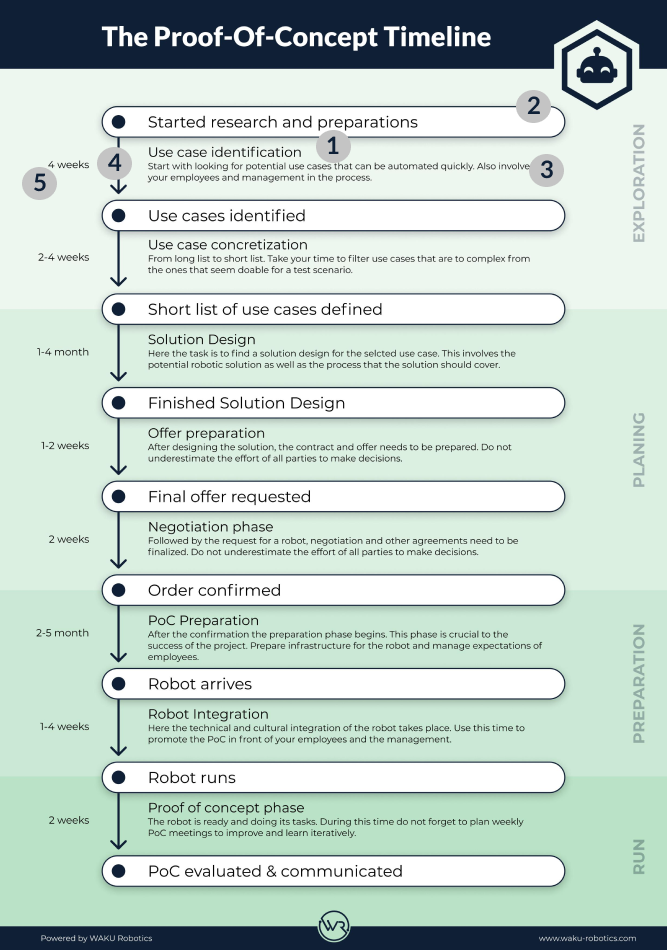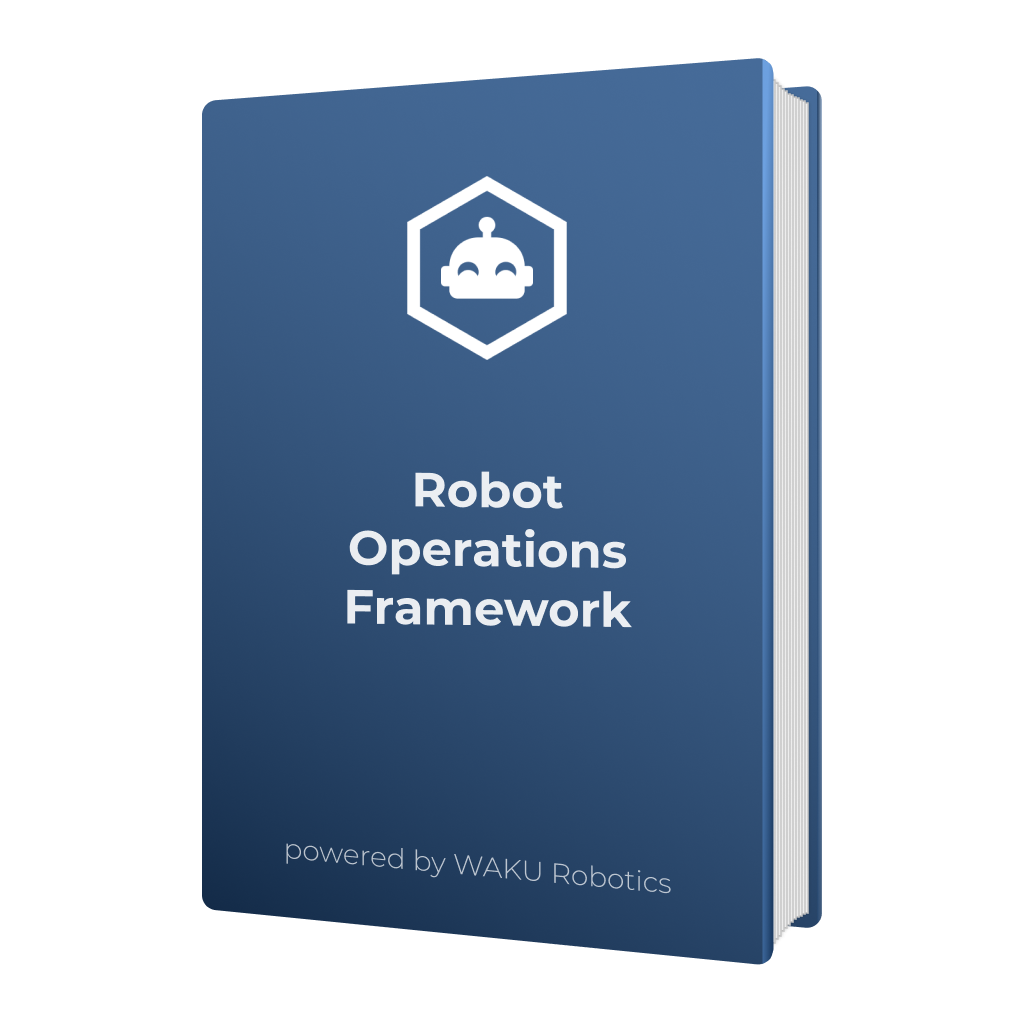How to Optimally Manage Time During a Proof of Concept with Mobile Robots (AGV&AMR)
Published on 10.02.2022
Timing is a key element in project management. During the execution of a proof of concept (PoC), an initial on-site pre-test with mobile robots, a timeline can support you in finding the right flow. If it is designed effectively it enables successful time management and thus an optimal timing of the PoC. In this article, we present a timeline that you can use as a template for your PoC.
Reading time: ca. 4 minutes
Structure of the timeline
The structure of the timeline of a PoC with mobile robots contains:
- Individual project phases
- Milestones of a project
- Concrete project activities
- Sequence of project activities
- Estimation of duration

Dowload the template of our timeline for the Poc with mobile robots here for free.
Individual phases of the timeline
The timeline is divided into the following phases:
1. Identification of the use case
First, you start exploring the market. You get a comprehensive overview of the market and prepare for the PoC. To do this, you can use LotsOfBots - the independent comparison platform for mobile robots in the area of logistics and production. LotsOfBots gives you a comprehensive overview of different mobile robots from numerous robot manufacturers for various use cases. The search for potential use cases for the PoC will also be made easier if you identify the processes where mobile robots already exist in logistics and production (e.g. picking, goods transport). Also, involve your employees in the search! Ask them about their expectations of the final use case. You can plan a period of 4 weeks for this step.
2. Concretizing the use cases
When concretizing the use cases, you can work your way from a long list to a short list. Filter all use cases that seem too complex. As a result, you receive a final short list of realizable use cases and can decide on one, which is the basis for the following planning. You should complete this process within 2-4 weeks.
3. Solution Design
After identifying the potential use case, you can start looking for possible robot solutions. For this, you need to approach the robot manufacturers of the selected robot systems and describe your use case. The robot manufacturers will work with you together on the solution design and plan a technically feasible solution. You should calculate 1-4 months for this.
4. Preparation of the offer
Once you have a preferred solution design, you can send out offers for it. Of course, you can get offers from several vendors. This phase usually takes 1-2 weeks.
5. Negotiation Phase
In the next step, you start the negotiation phase with the manufacturers. In the end, you decide on the offer that suits your requirements best. Confirming the offer and ordering the mobile robot results in the timeline for the shipment and arrival of the robot for your PoC. That needs approximately 2 weeks.
6. PoC Preparation
Now prepare for the arrival of the robot. For this, you can ask the manufacturer for manual and installation instructions. Your employees have certain expectations of the robot and may have some questions. Again, involve the stakeholders! Also prepare the technical requirements, network access, and infrastructure. You can estimate 2-5 months for this phase.
7. Integration of the robot
The mobile robot has been delivered and you have made all necessary preparations for the integration. Awesome! Now, you’re ready to perform a robot setup including the mapping on which the mobile robot will move in the test environment. You also set up all tasks and tests of the robot. Training the employees who will interact with the mobile robot is also essential here so that the robot can run reliably. This phase will take 1-4 weeks of your project.
8. Proof of Concept
After you have tested the mobile robot, you can perform an evaluation of the PoC. In this context, use your previously defined KPIs and evaluate them. Talk to the employees involved and the management team about the PoC and its results. After that, you can communicate the PoC within the company and externally if necessary. The last phase in the schedule will take about 2 weeks.
Another important hint
When designing your timeline, plan in some buffer time in case deadlines cannot be met. Unscheduled time delays can occur, for example, if the mobile robot delivery takes longer than expected or if involved employees are absent due to illness. Take enough time to explore mobile robots. Here you can also draw on the knowledge of robot experts who can help you select and procure the optimal robot solution. With WAKU Consulting we offer you packages for consulting and planning of logistics automation projects. We support you with exploring the mobile robot market (AGVs & AMRs) market and with finding the best solutions for you.
Conclusion
A solidly timed planned proof of concept makes it easier to get started with mobile robots in logistics and production. Knowing which phases need to be completed (for how long), what activities are involved, and what milestones will be achieved provides transparency and measurability of progress. The timeline is also important for internal communication with stakeholders, as it provides a basis for discussion when updating stakeholders - including all employees involved on-site. It ensures that everyone is up to date. Any problems can be identified and resolved at an early stage. It is advisable to plan sufficient buffer times for this.
Start your proof of concept with mobile robots now

More information about PoC with mobile robots (AGV&AMR) can be found in the Robot Operations Framework. Download the handbook for free and start your Robot Automation Journey. You can also use the checklists, posters, and other material to be optimally prepared for all the important steps of your Robot Automation Journey.
Feel free to contact us with any questions or suggestions. We’re looking forward to hearing from you!
WAKU Care
Software for Maintenance and Service Teams
Double Maintenance Efficiency.
Intuitive, digital and measurable.
Manage knowledge. Avoid chaos.
WAKU Robotics supports you in choosing the right robot for your application. We take care of the procurement of the robots as well as the on-site test. Our WAKU Care software helps you to operate the robots across manufacturers and to analyze the processes.
Contact WAKU